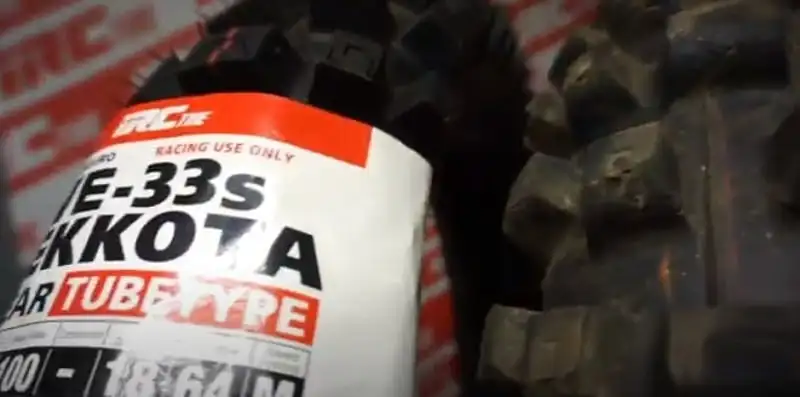Choosing the right dirt bike tire can be a daunting task. With so many compounds and tread patterns available, selecting a tire that fits your specific riding style and needs is crucial.
In this comprehensive guide, we’ll break down the key differences between tire compounds so you can make an informed decision when outfitting your bike.
Whether you’re a weekend trail rider or an aspiring extreme enduro racer, read on to find your perfect match!
Regular vs. Gummy Compounds: The Main Differences
When browsing dirt bike tires, you’ll notice they are available in regular and gummy compounds. What sets them apart?
- Gummy tires feature an ultra-soft, sticky rubber formulated for maximum traction and grip. This makes them ideal for technical, low-speed riding and extreme conditions. However, their soft composition also means they wear faster than regular compounds.
- Regular compounds utilize a firmer, more durable rubber that provides a balance of traction and longevity. They work well for versatile riding across different terrains and speeds.
While gummy tires undoubtedly provide more traction, their softer rubber comes at a cost. On average, they wear twice as fast as regular compounds. This can mean more frequent tire changes and expenses.
Key Takeaways
- Gummy tires sacrifice longevity for extreme grip and traction
- Regular compounds balance traction and durability
- Gummy tires wear much faster than regular rubber
Picking The Right Compound
So when should you opt for a gummy tire over a regular one? Here are a few key factors to consider:
Riding Terrain and Technique
Gummy tires excel in technical, low-speed terrain where maximum traction is needed. Rutted trails, rocky uphills, slippery mud – a soft compound thrives in these conditions.
Proper throttle and clutch control helps preserve gummy tire life. A grippier compound prevents slippage if you tend to spin your rear wheel excessively.
However, gummy tires are less ideal for high-speed riding. The extreme flex causes knob fatigue and tears. Stick with a regular compound if you frequently ride third and fourth-gear trails.
Type of Riding
Extreme enduro calls for the traction of a gummy tire without question. Maps like Erzberg and Tennessee Knockout demand the grip to conquer steep, rocky terrain.
Yet you can still get decent life from gummy rubber in pure low-speed technical riding.
For more versatile trail and cross-country riding, a regular compound works well. The firmer rubber handles different speeds and conditions without rapid wear. You’ll get the predictability needed for varying trails.
Budget and Maintenance Factors

The superior traction of gummy tires comes at a steeper price. You’ll also need to change them twice as often, given the soft rubber.
Make sure your riding truly requires the benefits of a gummy compound before taking the plunge. Otherwise, you may be spending unnecessary time and money on tire upkeep.
When Gummy Tires Do (And Don’t) Make Sense
Seeing real-world examples illustrates when gummy rubber shines versus standard compounds:
Tennessee Knockout 2022: High Speeds Fatigue Gummy Tires
During the 2022 TKO enduro, dry conditions led to unusually high speeds. Gummy tires like the IXO9W Kokoda struggled with the pace.
The extreme flex caused rapid knob fatigue and failure. Riders would’ve fared better on regular compounds that withstand high speed.
Local Trail Riding: Gummy Overkill for Typical Conditions
For standard local trail riding, gummy tires are overkill. Typical speeds and conditions don’t require their extreme grip and traction. Regular compounds provide enough traction for changing terrain at a fraction of the cost.
Frequently Asked Questions
Q: How long do gummy tires last compared to regular compounds?
A: On average, gummy tires last about half as long as regular compounds. Their soft, sticky rubber wears twice as fast.
Q: What’s the main benefit of gummy tires over regular ones?
A: The ultra-soft rubber in gummy tires provides extreme traction and grip. This gives them an advantage in technical, low-traction conditions.
Q: Are gummy tires good for high-speed riding and trails?
A: No, the extreme flex of gummy rubber at high speeds causes rapid tire fatigue and failure. Regular compounds are better suited for fast trails.
Q: When does it make sense to choose a gummy tire over a standard one?
A: For low-speed, extremely technical riding like rock gardens or slippery uphills. Also, challenging terrain like Erzberg or the Tennessee Knockout.
Q: Is a gummy tire overkill for typical local trail riding?
A: Most likely yes. Average trail speeds and conditions rarely require that level of extreme traction and grip. Regular compounds often work just fine.
Conclusion
Picking the right dirt bike tire compound requires honestly assessing your riding style. While gummy tires provide unmatched traction, their soft rubber comes with tradeoffs.
Low-speed technical riding and extreme enduro are often the best choices. But regular compounds strike the ideal balance of grip and longevity for high-speed trails and versatile conditions.
Considering your usual terrain and techniques helps determine the ideal tire compound. Don’t overspend on gummy rubber unless the added traction is absolutely necessary.
Only you can decide if the advantages outweigh the costs for your needs. Equipped with these insights, you can make the optimal tire choice to maximize both performance and value.
Previous Article: VX30 vs M5B EVO
Next Article: Dirt Bike Tire Setups for Supreme Performance
Recent Posts
Ultimate Track Hand Protection? Continue Reading
Icon Hooligan Facelift Gloves Review: Best for Urban Sport Riding?
Icon Hooligan Facelift Continue Reading
